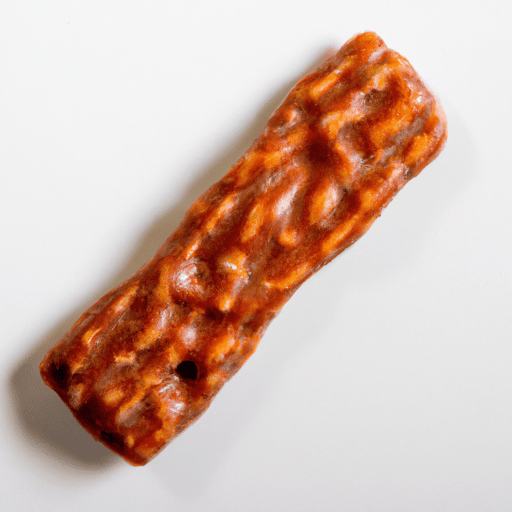The Irresistible Delight of Butterfinger Bar: A Sweetest Love Affair
There’s something truly magical about sinking your teeth into a Butterfinger bar. Its crispy and flaky texture, combined with the delightful taste of caramel and peanut butter, makes it an all-time favorite indulgence. In this blog post, we dive deep into the delectable world of Butterfinger bars, exploring their taste, common uses in cooking, nutritional value, and the intriguing history behind them.
The Taste of Bliss
Imagine a symphony of flavors dancing on your taste buds. The first bite of a Butterfinger bar introduces you to a triumphant crunch. Its crispy layers shatter, revealing the smooth and creamy peanut butter center that keeps you coming back for more. Balanced with a hint of sweetness from the caramel, it’s a flavor combination that instantly captivates your senses. The slight saltiness of the peanuts adds an extra layer of complexity, making each bite a heavenly experience.
Versatility in Cooking
Beyond its role as a go-to candy bar, the Butterfinger’s unique flavor profile opens up a world of possibilities in the kitchen. Crushed Butterfinger bars can be used as a delectable topping for ice cream, cupcakes, or even as a crunchy sprinkle on your morning pancakes. Incorporating Butterfinger pieces into your favorite cookie or brownie batter adds an irresistible twist to classic recipes. Let your creativity run wild with this versatile ingredient, exploring new ways to incorporate Butterfinger’s delightful crunch into your culinary creations.
Nutritional Value
While it’s undeniably delicious, indulging in a Butterfinger bar means striking a balance between enjoyment and moderation. A standard Butterfinger bar contains approximately 250 calories, 10 grams of fat, 40 grams of carbohydrates, and 3 grams of protein. It’s worth noting that these nutritional values may vary slightly depending on the size and specific recipe. As with any indulgence, it’s always important to savor Butterfinger bars in moderation and be mindful of your overall dietary choices.
A Remarkable History
The Butterfinger bar made its debut back in 1923, enchanting taste buds for nearly a century. Created by the Curtiss Candy Company, this iconic candy quickly became a beloved treat across the United States. Over the years, ownership of Butterfinger switched hands until Nestlé took the helm in 1990. The secret to its signature texture lies in the unique process of flaky peanut butter filling being panned and then covered with a layer of chocolate. This meticulous process ensures the unmistakable and delightful bite that we know and love today.
Fun Facts About Butterfinger Bars
Did you know that Butterfinger was briefly named “The Curtiss Candy Finger”? The name was eventually changed to Butterfinger to better represent its flaky texture and rich flavor.
In a survey conducted in 2020, Butterfinger bar was voted as one of the top ten favorite candy bars in the United States.
Butterfinger aficionados have been known to recreate the candy bar’s flavor in various homemade treats, including cakes, milkshakes, and even cocktails!
You may have noticed that Bart Simpson from the popular animated show “The Simpsons” is a fan of Butterfinger. The candy bar has been featured in the show’s marketing campaigns and episodes for over 30 years.
Butterfinger bars offer a truly unforgettable taste experience. Their flaky and crispy texture, combined with the creamy peanut butter center and caramel sweetness, make them a treat to be savored. Whether enjoyed on its own, used as a versatile cooking ingredient, or shared with friends, the Butterfinger bar has firmly established its place in the world of sweet indulgences. Next time you indulge in this classic candy, take a moment to appreciate its unique history and the joy it brings to your taste buds.
Origin and History:
- Butterfinger bar is a popular candy bar that was first introduced in the United States in 1923 by the Curtiss Candy Company.
Common Uses:
- Butterfinger bars are commonly enjoyed as a standalone candy bar, perfect for a quick sweet treat.
Unique Properties:
- The main component of a Butterfinger bar is its distinct crispy and flaky peanut butter-flavored center, which is covered in a layer of milk chocolate.
- The texture of a Butterfinger bar is often described as crunchy, with a unique texture that can be enjoyed by both kids and adults.
Nutritional Benefits:
- Butterfinger bars are not considered a nutritionally balanced food and are generally high in calories, sugar, and fat.
- A standard-size Butterfinger bar (2.1 oz or 60g) contains approximately 270 calories, 34 grams of carbohydrates, 13 grams of fat, and 4 grams of protein.
- Butterfinger bars are not a significant source of vitamins or minerals, but they do contain small amounts of calcium and iron.
Trivia:
- The advertising slogan for Butterfinger, “Nobody better lay a finger on my Butterfinger!” became very popular in the 1990s through a series of amusing and memorable commercials.
- Butterfinger has been featured in various TV shows and movies such as “The Simpsons,” where it is a favorite candy of the character Bart Simpson.




Use the share button below if you liked it.
It makes me smile, when I see it.